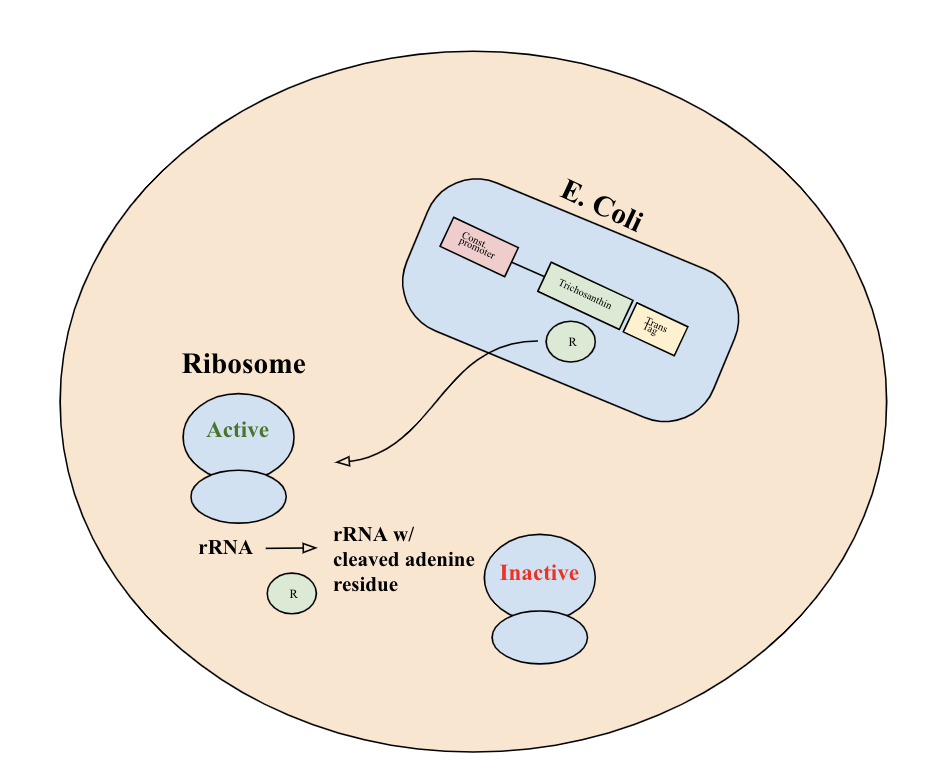Part:BBa_K3419001
Tricosanthin
Safety Flag
The iGEM Safety and Security Committee has placed a Red Flag on this part. This part presents safety risks beyond what is normal for the Registry. Researchers who plan to acquire and use this part should take special care to ensure they use it safely and responsibly. Contact safety [AT] igem [DOT] org with any questions.
Reason: Factors that help pathogens halt the host's DNA/RNA replication, transcription, or translation
If you are an iGEM team, you must submit a Check-In before acquiring and using this part! See the 2021 Safety Page for more information.
Usage and Biology
Note: All work on this basic part was done virtually through literature research due to COVID-19 restrictions.
Trichosanthin is a protein derived from Trichosanthes kirilowii, also known as the Chinese cucumber. It has been used in Eastern traditional medicine as an abortifacient and also functions as an antitumor agent due to its inactivation effect on eukaryotic ribosomes [1]. Trichosanthin is used in our project as an anti-cancer therapeutic protein that selectively kills tumor cells while leaving our engineered prokaryotic E. coli unaffected. We were able to confirm that E. coli would be able to produce this therapeutic based on a literature search [2]. Thus, our bacteria would perform their intended function in our genetic circuit.
Mechanism
Trichosanthin is produced constitutively by the engineered bacteria upon entry, and is exported into the cytoplasm of the tumor cells. Upon release into the cell, trichosanthin exhibits RNA N-glycosidase activity and depurinates the 28S rRNA of the 60S eukaryotic ribosomal subunit. Ribosome inhibition is achieved by interaction of trichosanthin with the ribosomal stalk protein P2 C-terminal tail. Binding to the C-terminal domain of ribosomal P protein achieves irreversible inactivation of eukaryotic ribosome activity and inhibition of tumor cell function. [3] Trichosanthin does not affect prokaryotic ribosomes, which allows E.coli to remain functional and act as a therapeutic delivery system. Since trichosanthin acts by inhibiting protein synthesis, its cytotoxic effects will be most deleterious to fast-growing cancer cells [4]. Additionally, our addition of a translocase tag allows for more efficient export of trichosanthin from the bacteria into the cytoplasm of the tumor cell [5].

References:
[1] Li, M. X., Yeung, H. W., Pan, L. P., & Chan, S. I. (1991). Trichosanthin, a potent HIV-1 inhibitor, can cleave supercoiled DNA in vitro. Nucleic acids research, 19(22), 6309–6312. https://doi.org/10.1093/nar/19.22.6309
[2] Zhu, R., Ng, T., Yeung, H., & Shaw, P. (2009). High level synthesis of biologically active recombinant trichosanthin in Escherichia coli. International Journal of Peptide and Protein Research, 39(1), 77-81. doi:10.1111/j.1399-3011.1992.tb01558.x
[3] Shi, W., Wong, K., & Shaw, P. (2018). Structural and Functional Investigation and Pharmacological Mechanism of Trichosanthin, a Type 1 Ribosome-Inactivating Protein. Toxins, 10(8), 335. doi:10.3390/toxins10080335
[4] Li, J., Li, H., Zhang, Z., Wang, N., & Zhang, Y. (2016). The anti-cancerous activity of recombinant trichosanthin on prostate cancer cell PC3. Biological research, 49(1), 21.
[5] Fang, E. F., Zhang, C. Z., Zhang, L., Wong, J. H., Chan, Y. S., Pan, W. L., . . . Ng, T. B. (2012). Trichosanthin Inhibits Breast Cancer Cell Proliferation in Both Cell Lines and Nude Mice by Promotion of Apoptosis. PLoS ONE, 7(9). doi:10.1371/journal.pone.0041592
| None |
